机器学习分布式框架Ray
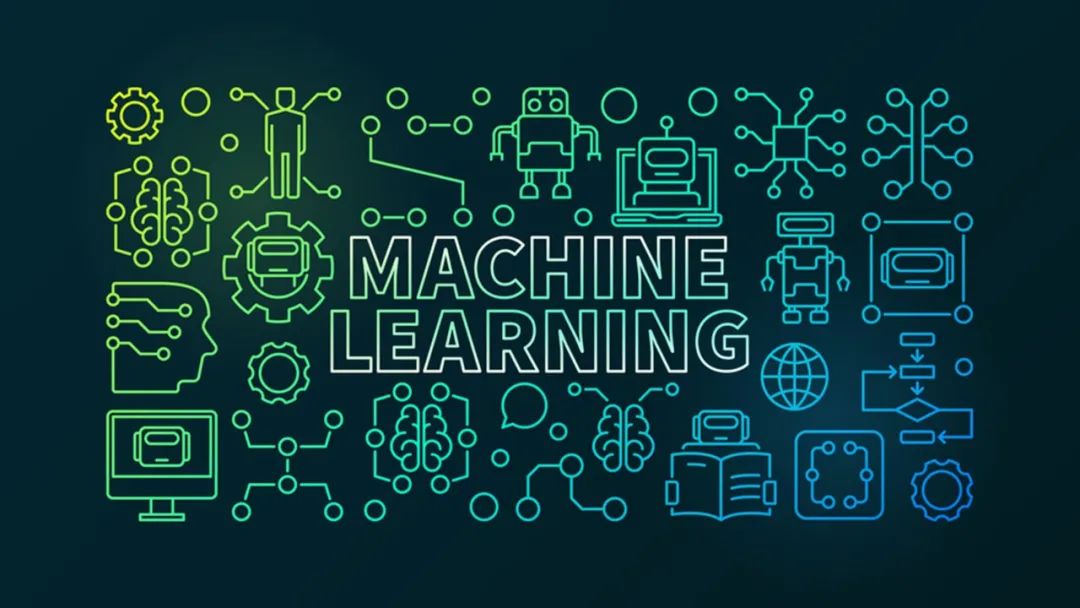
1.什么是Ray
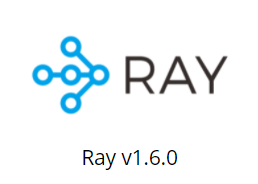
https://github.com/ray-project/ray
2. Ray架构
Ray: A Distributed Framework for Emerging AI Applications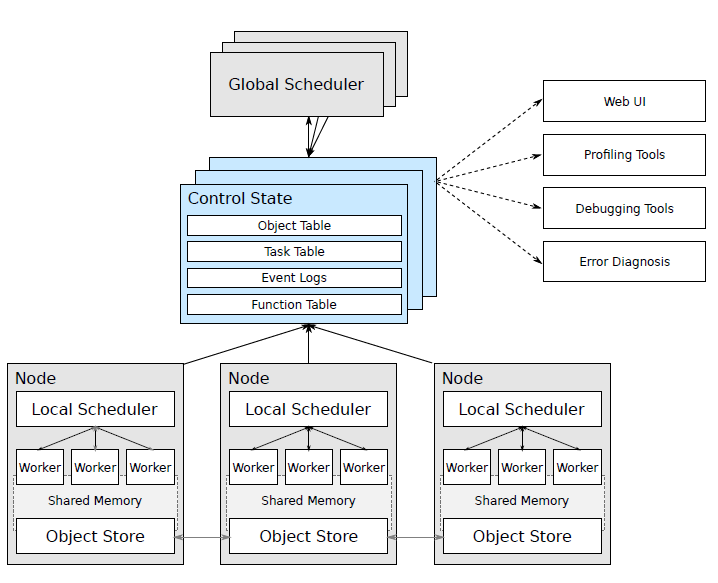
Node: 节点,主要是head和worker, head可以认为是Master,worker是执行任务的单元 每个节点都有自己的本地调度器local scheduler object store:一个内存对象存储,允许Node之间进行通信 scheduler:有两个调度器,每个节点都有本地的调度器, 在提交任务时,Local Scheduler会判断是否需要提交给Global Scheduler分发给其他worker来执行。 GCS:全局状态控制记录了Ray中各种对象的状态信息,可以认为是meta数据,是Ray容错的保证
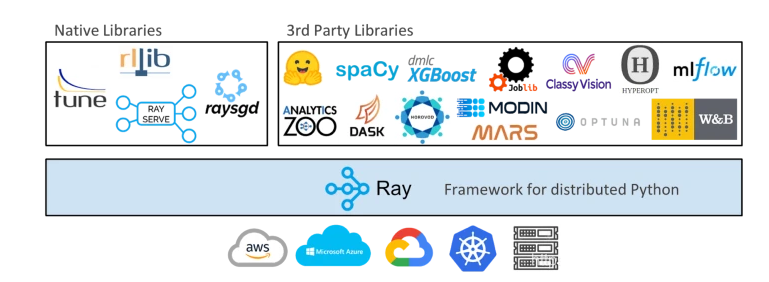
3. 简单使用
3.1 安装部署
pip install --upgrade pip
# pip install ray
pip install ray == 1.6.0
# ImportError: cannot import name 'deep_mapping' from 'attr.validators'
# pip install attr == 19.1.0
3.2 单机使用
简单例子 Ray 通过@ray.remote装饰器使得函数变成可分布式调用的任务。通过函数名.remote方式进行提交任务,通过ray.get方式来获取任务返回值。单击情况下和多线程异步执行的方式类似。 import time
import ray
ray.init(num_cpus = 4) # Specify this system has 4 CPUs.
@ray.remote
def do_some_work(x):
time.sleep(1) # Replace this is with work you need to do.
return x
start = time.time()
results = ray.get([do_some_work.remote(x) for x in range(4)])
print("duration =", time.time() - start)
print("results = ", results)
# duration = 1.0107324123382568
# results = [0, 1, 2, 3]remote返回的对象的id 如ObjectRef(7f10737098927148ffffffff0100000001000000)。需要通过ray.get来获取实际的值, 需要注意的是ray.get是阻塞式的调用,不能[ray.get(do_some_work.remote(x)) for x in range(4)] 注意小任务使用情况 需要注意的是ray分布式计算在调度的时候需要发费额外的时间,如调度,进程间通信以及任务状态的更新等等,所以避免过小的任务。可以把小任务进行合并 @ray.remote
def tiny_work(x):
time.sleep(0.0001) # Replace this is with work you need to do.
return x
start = time.time()
result_ids = [tiny_work.remote(x) for x in range(100000)]
results = ray.get(result_ids)
print("duration =", time.time() - start)ray.put ray.put() 把一个对象放到对象存储上,返回一个object id, 这个id可以在分布式机器上都可以调用,该操作为异步的。通过ray.get()可以是获取。 num = ray.put(10)
ray.get(num)ray.wait 如果任务返回多个结果,ray.get()会等所有结果都完成之后才会执行后续的操作。如果多个结果执行的耗时不同,此时短板在于最长的那个任务。 这个时候可以采用ray.wait()方法,ray.wait()返回执行完毕的和未执行完毕的任务结果,执行完成的结果可以继续后续的操作 import random
@ray.remote
def do_some_work(x):
time.sleep(random.uniform(0, 4)) # Replace this is with work you need to do.
return x
def process_incremental(sum, result):
time.sleep(1) # Replace this with some processing code.
return sum + result
start = time.time()
result_ids = [do_some_work.remote(x) for x in range(4)]
sum = 0
while len(result_ids):
done_id, result_ids = ray.wait(result_ids)
sum = process_incremental(sum, ray.get(done_id[0]))
print("duration =", time.time() - start, "\nresult = ", sum)
# duration = 5.270821809768677
# result = 6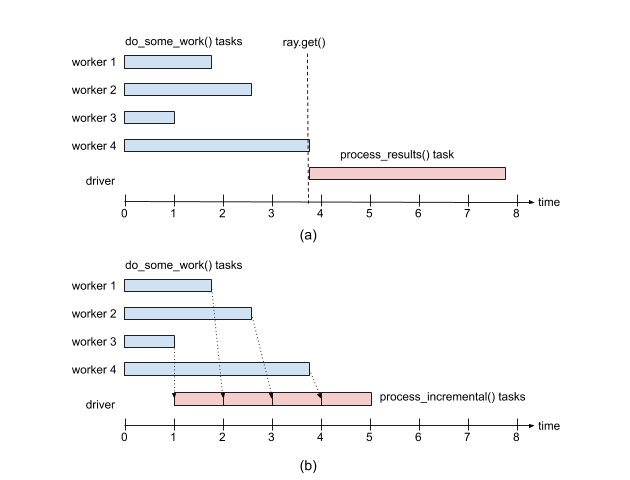
2.3 集群部署
ray start --head, 其他机器依次启动worker,注意需要指定head Node的地址确定关系,ray start --address 10.8.xx.3:6379。ray.stop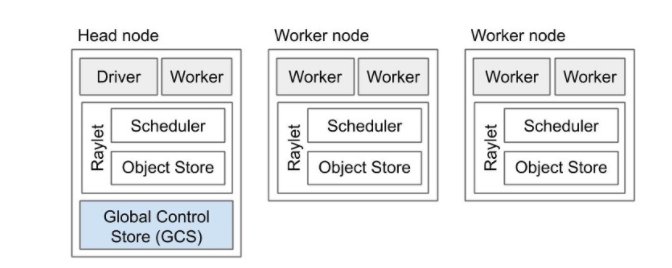
# To start a head node.
#ray start --head --num-cpus=<NUM_CPUS> --num-gpus=<NUM_GPUS>
ray start --head --node-ip-address 10.8.xx.3 --port=6379
# To start a non-head node.
# ray start --address=<address> --num-cpus=<NUM_CPUS> --num-gpus=<NUM_GPUS>
ray start --address 10.8.xx.3:6379 --node-ip-address 10.8.xx.3 --num-cpus 10 --temp-dir={your temp path}

提交任务 任何一台worker机器都可以提交任务, 先通过init连接Head Node就可以remote起来了。
import ray
ray.init(10.8.xx.3:6379)
3. 不同任务的例子
任务依赖 任务之间存在依赖关系,Ray和Spark一样也是通过生成DAG图的方式来确定依赖关系,确定可以并行跑的任务。如下图所示zeros是可以并行跑的。 import numpy as np
# Define two remote functions. Invocations of these functions create tasks
# that are executed remotely.
@ray.remote
def multiply(x, y):
return np.dot(x, y)
@ray.remote
def zeros(size):
return np.zeros(size)
# Start two tasks in parallel. These immediately return futures and the
# tasks are executed in the background.
x_id = zeros.remote((100, 100))
y_id = zeros.remote((100, 100))
# Start a third task. This will not be scheduled until the first two
# tasks have completed.
z_id = multiply.remote(x_id, y_id)
# Get the result. This will block until the third task completes.
z = ray.get(z_id)
print(z)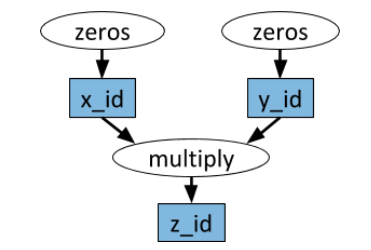
有状态任务 上面提到的任务都是无状态的(除依赖外),即任务之间都是无关系的。Ray也是支持有状态的任务成为Actor。常是在python class上加@ray.remote,ray会跟踪每个class内部状态的不同状态。 @ray.remote
class Counter(object):
def __init__(self):
self.n = 0
def increment(self):
self.n += 1
def read(self):
return self.n
counters = [Counter.remote() for i in range(4)]
# 不断的执行可以每个counter计数不断增加
[c.increment.remote() for c in counters]
futures = [c.read.remote() for c in counters]
print(ray.get(futures))
# [1, 1, 1, 1]
# [11, 11, 11, 11]map-reduce 任务 map-reduce任务其实可以其他分布式任务是一样的。主要是各种聚合操作。Map-Reduce常规操作如下 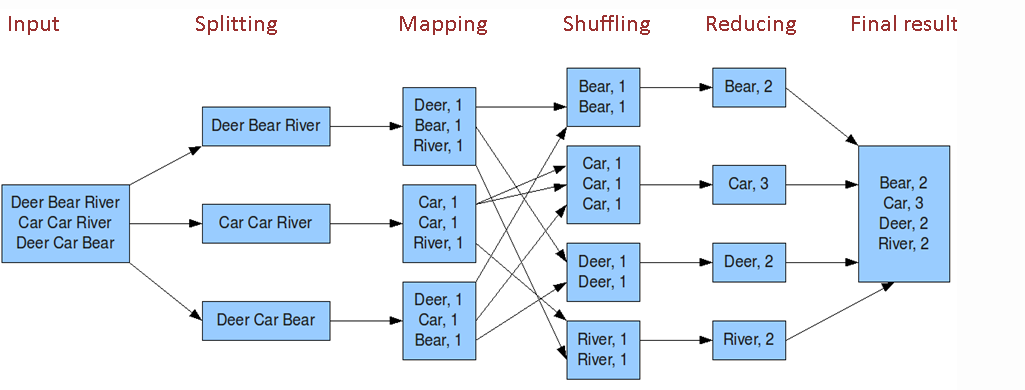
- word count例子见:https://github.com/ray-project/ray/blob/master/doc/examples/streaming/streaming.py这里举一个简单的例子: @ray.remote
def map(obj, f):
return f(obj)
@ray.remote
def sum_results(*elements):
return np.sum(elements)
items = list(range(100))
map_func = lambda i : i*2
remote_elements = [map.remote(i, map_func) for i in items]
# simple reduce
remote_final_sum = sum_results.remote(*remote_elements)
result = ray.get(remote_final_sum)
# tree reduce
intermediate_results = [sum_results.remote(
*remote_elements[i * 20: (i + 1) * 20]) for i in range(5)]
remote_final_sum = sum_results.remote(*intermediate_results)
result = ray.get(remote_final_sum)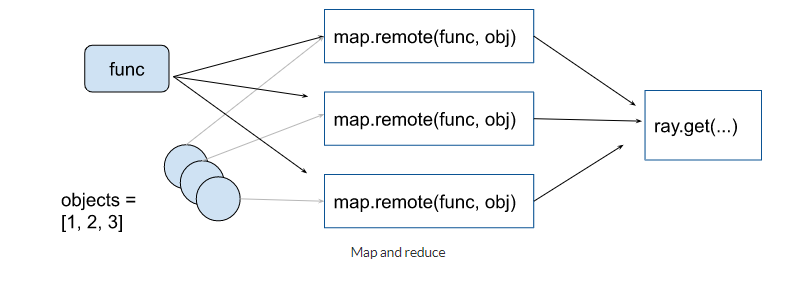
训练模型如pytorch 官网提供了 Best Practices: Ray with PyTorch, 主要是下载训练/测试数据和训练多个模型(感觉不是很实用)。训练多个模型,可以进行参数融合。参见 https://docs.ray.io/en/latest/using-ray-with-pytorch.html
4. 总结
Ray是UC Berkeley RISELab新推出的高性能分布式执行框架, Spark也是伯克利出品的 Ray架构关键:两个调度器, Head和worker节点,GCS全局状态控制保证计算容错 Ray应用简单:@ray.remote把任务变成分布式任务, x.remote提交任务, get/wait获取结果 集群不是:ray start Ray支持多种任务:有依赖DAG,有状态Actor以及深度学习支持 不断丰富的库:RaySERVE, RaySGD, RayTune, Ray data,rllib
作者简介:wedo实验君, 数据分析师;热爱生活,热爱写作
赞 赏 作 者





评论
